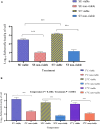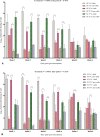Development of PMAxxTM-Based qPCR for the Quantification of Viable and Non-viable Load of Salmonella From Poultry Environment
- PMID: 33072053
- PMCID: PMC7536286
- DOI: 10.3389/fmicb.2020.581201
Development of PMAxxTM-Based qPCR for the Quantification of Viable and Non-viable Load of Salmonella From Poultry Environment
Abstract
Determining the viable and non-viable load of foodborne pathogens in animal production can be useful in reducing the number of human outbreaks. In this study, we optimized a PMAxxTM-based qPCR for quantifying viable and non-viable load of Salmonella from soil collected from free range poultry environment. The optimized nucleic acid extraction method resulted in a significantly higher (P < 0.05) yield and quality of DNA from the pure culture and Salmonella inoculated soil samples. The optimized primer for the amplification of the invA gene fragment showed high target specificity and a minimum detection limit of 102 viable Salmonella from soil samples. To test the optimized PMAxxTM-based qPCR assay, soil obtained from a free range farm was inoculated with Salmonella Enteritidis or Salmonella Typhimurium, incubated at 5, 25, and 37°C over 6 weeks. The survivability of Salmonella Typhimurium was significantly higher than Salmonella Enteritidis. Both the serovars showed moisture level dependent survivability, which was significantly higher at 5°C compared with 25°C and 37°C. The PMAxxTM-based qPCR was more sensitive in quantifying the viable load compared to the culture method used in the study. Data obtained in the current study demonstrated that the optimized PMAxxTM-based qPCR is a suitable assay for quantification of a viable and non-viable load of Salmonella from poultry environment. The developed assay has applicability in poultry diagnostics for determining the load of important Salmonella serovars containing invA.
Keywords: PMAxx-based qPCR; Salmonella contamination; Salmonella load; poultry production; viability assay.
Copyright © 2020 Zhang, Khan and Chousalkar.
Figures









Similar articles
-
qPCR detection of viable Bacillus cereus group cells in cosmetic products.Sci Rep. 2023 Mar 18;13(1):4477. doi: 10.1038/s41598-023-31128-3. Sci Rep. 2023. PMID: 36934171 Free PMC article.
-
Point-of-Care Diagnostic System for Viable Salmonella Species via Improved Propidium Monoazide and Recombinase Polymerase Amplification Based Nucleic Acid Lateral Flow.Diagnostics (Basel). 2024 Apr 17;14(8):831. doi: 10.3390/diagnostics14080831. Diagnostics (Basel). 2024. PMID: 38667476 Free PMC article.
-
Quantification of Viable Brochothrix thermosphacta in Cold-Smoked Salmon Using PMA/PMAxx-qPCR.Front Microbiol. 2021 Jul 14;12:654178. doi: 10.3389/fmicb.2021.654178. eCollection 2021. Front Microbiol. 2021. PMID: 34335490 Free PMC article.
-
Salmonellosis acquired from poultry.Curr Opin Infect Dis. 2016 Oct;29(5):514-9. doi: 10.1097/QCO.0000000000000296. Curr Opin Infect Dis. 2016. PMID: 27434307 Review.
-
Impact of sporadic reporting of poultry Salmonella serovars from selected developing countries.J Infect Dev Ctries. 2015 Jan 15;9(1):1-7. doi: 10.3855/jidc.5065. J Infect Dev Ctries. 2015. PMID: 25596565 Review.
Cited by
-
Investigation of the Potential of Heterophil/Lymphocyte Ratio as a Biomarker to Predict Colonization Resistance and Inflammatory Response to Salmonella enteritidis Infection in Chicken.Pathogens. 2022 Jan 7;11(1):72. doi: 10.3390/pathogens11010072. Pathogens. 2022. PMID: 35056020 Free PMC article.
-
Advances in detection methods for viable Salmonella spp.: current applications and challenges.Anal Sci. 2023 Oct;39(10):1643-1660. doi: 10.1007/s44211-023-00384-8. Epub 2023 Jun 28. Anal Sci. 2023. PMID: 37378821 Review.
-
A PMAxxTM qPCR Assay Reveals That Dietary Administration of the Microalgae Tetraselmis chuii Does Not Affect Salmonella Infantis Caecal Content in Early-Treated Broiler Chickens.Vet Sci. 2022 Sep 8;9(9):487. doi: 10.3390/vetsci9090487. Vet Sci. 2022. PMID: 36136705 Free PMC article.
-
Survival of a surrogate African swine fever virus-like algal virus in feed matrices using a 23-day commercial United States truck transport model.Front Microbiol. 2022 Dec 9;13:1059118. doi: 10.3389/fmicb.2022.1059118. eCollection 2022. Front Microbiol. 2022. PMID: 36569067 Free PMC article.
-
qPCR detection of viable Bacillus cereus group cells in cosmetic products.Sci Rep. 2023 Mar 18;13(1):4477. doi: 10.1038/s41598-023-31128-3. Sci Rep. 2023. PMID: 36934171 Free PMC article.
References
-
- Bellehumeur C., Boyle B., Charette S. J., Harel J., L’homme Y., Masson L., et al. (2015). Propidium monoazide (PMA) and ethidium bromide monoazide (EMA) improve DNA array and high-throughput sequencing of porcine reproductive and respiratory syndrome virus identification. J. Virol. Methods 222 182–191. 10.1016/j.jviromet.2015.06.014 - DOI - PMC - PubMed
-
- Cools D., Merckx R., Vlassak K., Verhaegen J. (2001). Survival of E. coli and Enterococcus spp. derived from pig slurry in soils of different texture. Appl. Soil Ecol. 17 53–62. 10.1016/s0929-1393(00)00133-5 - DOI
LinkOut - more resources
Full Text Sources

